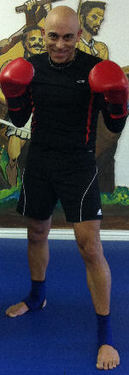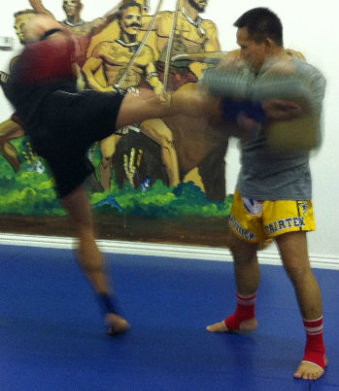About Muay Thai

I should look more serious!
Clinch and neck wrestling(Chap kho) See also: Muay Thai clinch In Western boxing the two fighters are separated when they clinch; in muay thai, however, they are not. It is often in the clinch where knee and elbow techniques are used. To strike and bind the opponent for both offensive and defensive purposes, small amounts of stand-up grappling are used in the clinch. The front clinch should be performed with the palm of one hand on the back of the other. There are three reasons why the fingers must not be intertwined. 1) In the ring fighters are wearing boxing gloves and cannot intertwine their fingers. 2) The Thai front clinch involves pressing the head of the opponent downwards, which is easier if the hands are locked behind the back of the head instead of behind the neck. Furthermore the arms should be putting as much pressure on the neck as possible. 3) A fighter may incur an injury to one or more fingers if they are intertwined, and it becomes more difficult to release the grip in order to quickly elbow the opponent's head.
A correct clinch also involves the fighter's forearms pressing against the opponent's collar bone while the hands are around the opponent's head rather than the opponent's neck. The general way to get out of a clinch is to push the opponent's head backwards or elbow them, as the clinch requires both participants to be very close to one another. Additionally, the non-dominant clincher can try to "swim" their arm underneath and inside the opponent's clinch, establishing the previously non-dominant clincher as the dominant clincher.
Muay thai has several other variants of the clinch or chap kho [tɕàp kʰɔː], including:
Defense against attacks Defenses in muay thai are categorized in six groups:
I have been training Muay Thai for a short while and I absolutely love it.
It is quite the rush, and the kind of high intensity workout that really gets me going.
A correct clinch also involves the fighter's forearms pressing against the opponent's collar bone while the hands are around the opponent's head rather than the opponent's neck. The general way to get out of a clinch is to push the opponent's head backwards or elbow them, as the clinch requires both participants to be very close to one another. Additionally, the non-dominant clincher can try to "swim" their arm underneath and inside the opponent's clinch, establishing the previously non-dominant clincher as the dominant clincher.
Muay thai has several other variants of the clinch or chap kho [tɕàp kʰɔː], including:
- arm clinch: One or both hands controls the inside of the defender's arm(s) and where the second hand if free is in the front clinch position. This clinch is used to briefly control the opponent before applying a knee strike or throw
- side clinch: One arm passes around the front of the defender with the attacker's shoulder pressed into the defender's arm pit and the other arm passing round the back which allows the attacker to apply knee strikes to the defender's back or to throw the defender readily.
- low clinch: Both controlling arms pass under the defender's arms, which is generally used by the shorter of two opponents.
- swan-neck: One hand around the rear of the neck is used to briefly clinch an opponent before a strike.
Defense against attacks Defenses in muay thai are categorized in six groups:
- Blocking – defender's hard blocks to stop a strike in its path so preventing it reaching its target (e.g. the shin block described in more detail below)
- Redirection – defender's soft parries to change the direction of a strike (e.g. a downwards tap to a jab) so that it misses the target
- Avoidance – moving a body part out of the way or range of a strike so the defender remains in range for a counter-strike. For example, the defender moves their front leg backwards to avoid the attacker's low kick, then immediately counters with a roundhouse kick. Or the defender might lay their head back from the attacker's high roundhouse kick then counter-attack with a side kick.
- Evasion – moving the body out of the way or range of a strike so the defender has to move close again to counter-attack, e.g. defender jumping laterally or back from attacker's kicks
- Disruption – Pre-empting an attack e.g. with defender using disruptive techniques like jab, foot-thrust or low roundhouse kick, generally called a "leg kick"(to the outside or inside of the attacker's front leg, just above the knee) as the attacker attempts to close distance
- Anticipation – Defender catching a strike (e.g. catching an roundhouse kick to the body) or countering it before it lands (e.g. defender's low kick to the supporting leg below as the attacker initiates a high roundhouse kick).
I have been training Muay Thai for a short while and I absolutely love it.
It is quite the rush, and the kind of high intensity workout that really gets me going.
A Muay Thai kick is very different than a Karate kick

Master Manop teaching me how to deliver the perfect kick.
Punches and kicks Defensively, the concept of "wall of defense" is used, in which shoulders, arms and legs are used to hinder the attacker from successfully executing techniques. Blocking is a critical element in muay thai and compounds the level of conditioning a successful practitioner must possess. Low and mid body roundhouse kicks are normally blocked with the upper portion of a raised shin. High body strikes are blocked ideally with the forearms and shoulder together, or if enough time is allowed for a parry, the glove (elusively), elbow, or shin will be used. Mid section roundhouse kicks can also be caught/trapped, allowing for a sweep or counter-attack to the remaining leg of the opponent. Punches are blocked with an ordinary boxing guard and techniques similar, if not identical, to basic boxing technique. A common means of blocking a punch is using the hand on the same side as the oncoming punch. For example, if an orthodox fighter throws a jab (being the left hand), the defender will make a slight tap to redirect the punch's angle with the right hand. The deflection is always as small and precise as possible to avoid unnecessary energy expenditure and return the hand to the guard as quickly as possible. Hooks are most often blocked with a motion most often described as "combing the hair", that is, raising the elbow forward and effectively shielding the head with the forearm, flexed biceps and shoulder. More advanced muay thai blocks are usually in the form of counter-strikes, using the opponents weight (as they strike) to amplify the damage that the countering opponent can deliver. This requires impeccable timing and thus can generally only be learned by many repetitions.

